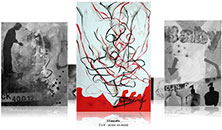Ever asked yourself "Do I have OCD"? If not, have you ever wondered what having obsessive compulsive disorder feels like?
Well, if you have to wonder then you are blessed to be free from the constant agonizing, intrusive thoughts that come standard with OCD. If you don't know how you can tell if you, your loved one or your child have obsessive compulsive disorder, then maybe I can help with the following content.A few symbolic points to my example are:
- As far as I know, the thoughts and compulsions never go away
- The obsessiveness may change from one form to another (e.g. cleaning to checking to counting) but always exists. Its like trying to fill a bottomless pit
- Some moments the thought patterns will be less intrusive and less intense than others
- Initial rituals or compulsive acts are exhaustively completed before moving on to another act. Even if the second act is a normal everyday occurrence like getting out of bed
- Obsessive compulsive disorder wastes extraordinary amounts of time, but the sufferer cannot move on (with comfort and ease of mind) until the ritual is complete - no matter how illogical the actions may be
You can move your cursor over the bottles to increase the speed and the complication of the counting.
Now times this feeling by 100 and do it every day! Welcome to the world of a typical OCD suffer.
The above example tries to demonstrate how mentally exhausting dealing with just one "C" of the (4) notorious C(s) of this disorder can be: counting.
The four C(s) of OCD are Cleaning, Counting, Checking and Canceling. Even though you may think it is nonsense and a waste of time to count the single bottle as it spins around, you have to do it before you can move on. You have to do it because your mind tells you that you must!
Once I asked a psychiatrist which out of all the metal disorders, in her opinion, would be the worst to have and live with... you guessed it, she said obsessive compulsive disorder. Her main reasoning was that it just never stops. OCD is always gnawing at the brain. Also, that the sufferer is conscious and perfectly aware of the behaviors he or she is doing unlike some of the other painful metal disorders like bi-polar, schizophrenia and manic depression.
Without the functional healthy balance of Serotonin in the brain, easy-to-do normal everyday happenings like reading a page of text in normal order become enormous time consuming tasks.
In my fine artwork I try to represent this dichotomy of simplicity in everyday normality with the painful complications the unbalanced mind can manufacture.

